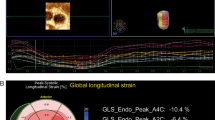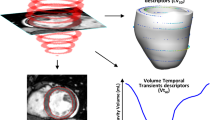Abstract
Complexity-based analyses may quantify abnormalities in heart rate variability (HRV). The aim of this study was to investigate the clinical and prognostic significances of dynamic HRV changes in patients with stress-induced cardiomyopathy Takotsubo syndrome (TS) by means of linear and nonlinear analysis. Patients with TS were included in study after complete noninvasive and invasive cardiovascular diagnostic evaluation and compared to an age and gender matched control group of healthy subjects. Series of R–R interval and of ST–T interval values were obtained from 24-h ECG recordings after digital sampling. HRV analysis was performed by ‘range rescaled analysis’ to determine the Hurst exponent, by detrended fluctuation analysis to quantify fractal long-range correlation properties, and by approximate entropy to assess time-series predictability. Short- and long-term fractal-scaling exponents were significantly higher in patients with TS in acute phases, opposite to lower approximate entropy and Hurst exponent, but all variables normalized in a few weeks. Dynamic HRV analysis allows assessing changes in complexity features of HRV in TS patients during the acute stage, and to monitor recovery after treatment, thus complementing traditional ECG and clinically analysis.




Similar content being viewed by others
References
Bassingthwaighte JB, Raymond GM (1994) Evaluating rescaled range analysis for time series. Ann Biomed Eng 22(4):434–444
Brouwer J, Van Veldhuisen DJ, Man in′t Veld AJ, Haaksma J, Dijk A, Visser KR, Boomsma F, Dunselman PHJM, Lie KI, and for the Dutch Ibopamine Multicentre Trial Study Group (1996) Prognostic value of heart rate variability during long-term follow-up in patients with mild to moderate heart failure. J Am Coll Cardiol 28:1183–1189
Castiglioni P, Parati G, Cividjian A, Quintin L, Di Rienzo M (2009) Local scale exponents of blood pressure and heart rate variability by detrended fluctuation analysis: effect of posture, exercise, and aging. IEEE Trans Biomed Eng 56(3):675–684
Castiglioni P, Parati G, Di Rienzo M, Carabalona R, Cividjian A, Quintin L (2011) Scale exponents of blood pressure and heart rate during autonomic blockade as assessed by detrended fluctuation analysis. J Physiol 589(2):355–369
Data Acquisition and Communication (2002) http:/www.iotech.com
DePetrillo PB, Speers D, Ruttiman UE (1999) Determining the Hurst Exponent of fractal time series and its application to electrocardiographic analysis. Comput Biol Med 29:393–406
Derrick D (2009) The Broken Heart syndrome: understanding Takotsubo cardiomyopathy. Critical Care Nurse 29:49–57
Fischer R, Akay M (1996) A comparison of analytic methods for the study of fractional Brownian motion. Ann Biomed Eng 24:537–543
Glass L (1999) Chaos and heart rate variability. J Cardiovasc Electrophysiol 10:1358–1360
Goldberger AL, Amaral LA, Glass L, Hausdorff JM, Ivanov PCh, Mark RG, Mietus JE, Moody GB, Peng CK, Stanley HE (2000) PhysioBank, PhysioToolkit, and PhysioNet: components of a new research resource for complex physiologic signals. Circulation 101(23):215–220
Goldberger AL (1996) Non-linear dynamics for clinicians: chaos theory, fractals, and complexity at bedside. Lancet 347:1312–1314
Hausdorff JM, Peng CK, Ladin Z, Wei JY, Goldberger AL (1995) Is walking a random walk? Evidence for long-range correlations in the stride interval of human gait. J Appl Physiol 78:349–358
Heitmann A, Huebner T, Schroeder R, Perz S, Voss A (2011) Multivariate short-term heart rate variability: a pre-diagnostic tool for screening heart disease. Med Biol Eng Comput. 49(1):41–50 PMID: 21140234
Huikuri HV (1995) Heart rate variability in coronary artery disease. J Intern Med 237:349–357
Huikuri HV, Makikallio TH, Perkiomaki J (2003) Measurement of heart rate variability by methods based on nonlinear dynamics. Electrocardiology 36(Suppl):95–99
Knežević A, Martinis M, Krstačić G, Vargović E (2005) Changes in multifractal properties for stable angina pectoris. Physica A 358(2–4):505–515
Krstacic G (2002) Dissertation: non-linear dynamics in short time series in patient with stable coronary heart disease. Zagreb University School of Medicine, Zagreb
Krstacic G, Krstacic A, Smalcelj A, Milicic D, Jembrek-Gostovic M (2007) The Chaos theory and non-linear dynamics in heart rate variability analysis: does it work in short time series in patients with coronary heart disease? Annals Noninvasive Electrocardiol 12(2):130–136
Makikkalio TM, Ristimae T, Airaksinen AE, Peng CK, Goldberger AL, Huikuri HV (1998) Heart rate dynamics in patients with stable angina and utility of fractal and complexity measures. Am J Cardiol 81:27–31
Makikallio TH, Hoiber S, Kober L, Torp-Pedersen C, Peng CK, Goldberger AL, Huikuri H, TRACE Investigators (1999) Fractal analysis of heart rate dynamics as a predictor of mortality in patients with depressed left ventricular function after acute myocardial infarction. Am J Cardiol 83:836–839
Martinis M, Knežević A, Krstačić G, Vargović E (2004) Changes in the Hurst exponent of heartbeat intervals during physical activity. Phys Rev E 70(1):12903
Melillo P, Fusco R, Sansone M, Bracale M, Pecchia L (2011) Discrimination power of long-term heart rate variability measures for chronic heart failure detection. Med Biol Eng Comput. 49(1):67–74 PMID: 21203855
Novo S, Akashi Y, Arbustini A, Assennato P, Azzarelli S, Barbaro G, Fazio G, Fedele F, Giordan M, Mazzarotto P, Modena MG, Novo G, Parodi G, Rapezzi C, Sconci F, Sganzerla P, Tona F, Salerno-Uriarte JA (2008) Takotsubo cardiomyopathy: a consensus document. G Ital Cardiol 9:785–797
Novo S, Carità P, Fazio G, Novo G (2010) Takotsubo cardiomyopathy. An article from the E-Journal of the ESC council for cardiology practice. E-Journal 8(39), 05 July 2010
Orini M, Bailón R, Enk R, Koelsch S, Mainardi L, Laguna P (2010) A method for continuously assessing the autonomic response to music-induced emotions through HRV analysis. Med Biol Eng Comput 48(5):423–433
Ortak J, Khattab K, Barantke M, Wiegand UK, Bänsch D, Ince H, Nienaber CA, Bonnemeier H (2009) Evolution of cardiac autonomic nervous activity indices in patients presenting with transient left ventricular apical ballooning. Pacing Clin Electrophysiol 32(Suppl. 1):S21–S25
Pagani M, Montano N, Porta A, Malliani A, Abboud FM, Birkett C, Somers VK (1997) Relationship between spectral components of cardiovascular variability and direct measures of muscle sympathetic nerve activity in humans. Circulation 95:1441–1448
Parati G, Murray E (2012) The human sympathetic nervous system: its relevance in hypertension and heart failure. Eur Heart J 33:1058–1066
Parati G, Saul JP, Di Rienzo M, Mancia G (1995) Spectral analysis of blood pressure and heart rate variability in evaluating cardiovascular regulation. A critical appraisal. Hypertension 25(6):276–286
Peña MA, Echeverría JC, García MT, González-Camarena R (2009) Applying fractal analysis to short sets of heart rate variability data. Med Biol Eng Comput. 47(7):709–717
Peng CK, Havlin S, Stanley HE, Goldberger AL (1995) Quantification of scaling exponents and crossover phenomena in nonstationary heartbeat time series. Chaos 5:82–87
Pincus SM, Viscarello RR (1992) Approximate entropy: a regularity statistic for fetal heart rate analysis. Obst Gynecol 79:249–255
Pincus SM (1991) Approximate entropy as a measure of system complexity. Proc Natl Acad Sci USA 88:2297–2301
Pincus SM, Huang WM (1992) Approximate entropy: statistical properties and applications. Commun Stat Theory Method 21:3061–3077
Pincus SM, Goldberger AL (1994) Physiologic time-series analysis: what does regularity quantify? Am J Physiol 226:H1643–H1656
Regnante RA, Zuzek RW, Weinseir S, Latif SR, Linsky RA, Ahmed HN, Sadiq I (2009) Clinical characteristics and 4-year outcomes of patients in the Rhode Island Takostsubo cardiomyopathy. Am J Cardiol 103:1015–1019
Saul JP, Albrecht P, Berger RD, Cohen RJ (1987) Analysis of long-term heart rate variability: methods, 1/f scaling and implications. In: Computers in cardiology. Silver Spring. IEEE Computer Society Press, Baltimore, pp 419–422
Saermark K, Moeller M, Hintze U, Moelgaard H, Bloch-Thomsen PE, Huikuri H, Makikallio T, Levitan J, Lewkowicz M (2000) Comparison of recent methods of analysing heart rate variability. Fractal 8:315–322
Sharkey SW, Windenburg DC, Lesser JR, Maron MS, Hauser RG, Lesser JN, Haas TS, Hodges JS, Maron BJ (2010) Natural history and expansive clinical profile of stress (tako-tsubo) cardiomyopathy. J Am Coll Cardiol 55(4):333–341
Task Force Task Force of the European Society of Cardiology and the North American Society of Pacing and Electrophysiology (1996) Heart rate variability: standards of measurement, physiological interpretation, and clinical use. Circulation 93:1043–1065
Wittstein IS, Thiemann DR, Lima JA, Baughman KL, Schulman SP, Gerstenblith G, Wu KC, Bivalacqua TJ, Champion HC (2005) Neurohormonal features of myocardial stunning due to sudden emotional stress. New Engl J Med 352:539–548
Author information
Authors and Affiliations
Corresponding author
Rights and permissions
About this article
Cite this article
Krstacic, G., Parati, G., Gamberger, D. et al. Heart rate variability and nonlinear dynamic analysis in patients with stress-induced cardiomyopathy. Med Biol Eng Comput 50, 1037–1046 (2012). https://doi.org/10.1007/s11517-012-0947-z
Received:
Accepted:
Published:
Issue Date:
DOI: https://doi.org/10.1007/s11517-012-0947-z




